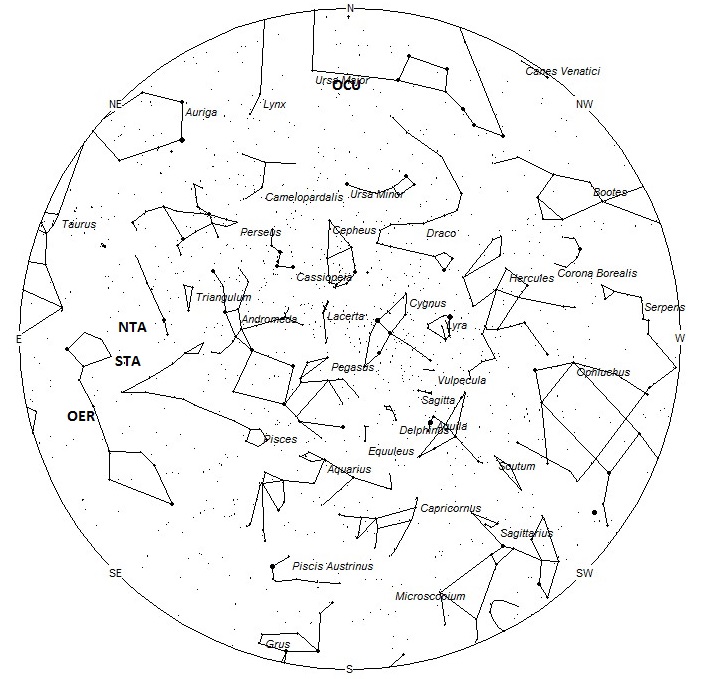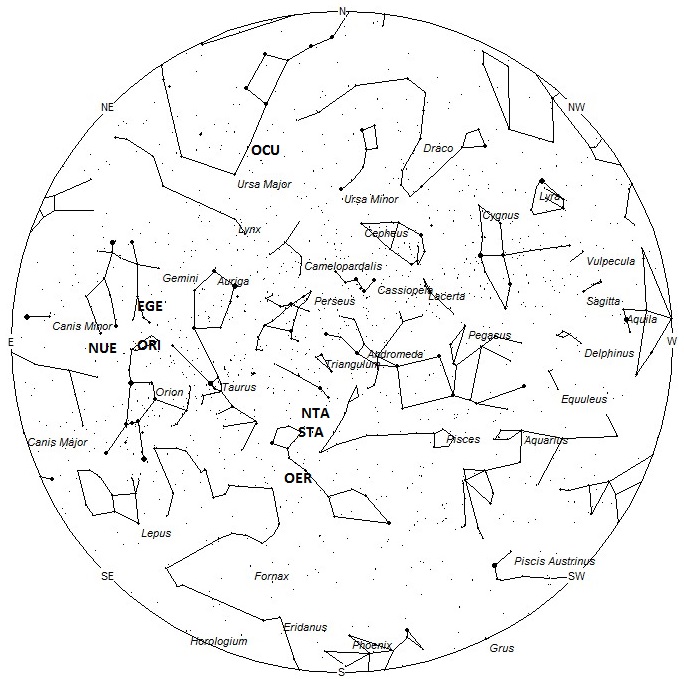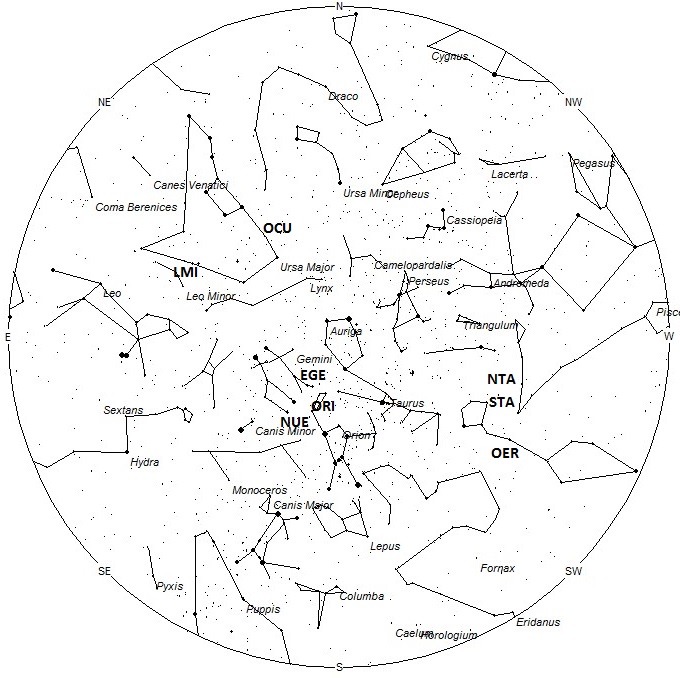
During this period the moon will reach its new phase on Thursday October 19th. At this time the moon will be located near the sun and will be invisible at night. This weekend the waning crescent moon will rise during the early morning hours but will not interfere with viewing meteors as long as you keep the moon out of your field of view. The estimated total hourly meteor rates for evening observers this week is near 4 for those viewing from the northern hemisphere and 3 for those located south of the equator. For morning observers the estimated total hourly rates should be near 17 as seen from mid-northern latitudes and 16 from the southern tropics. The actual rates will also depend on factors such as personal light and motion perception, local weather conditions, alertness and experience in watching meteor activity. Note that the hourly rates listed below are estimates as viewed from dark sky sites away from urban light sources. Observers viewing from urban areas will see less activity as only the brighter meteors will be visible from such locations.
The radiant (the area of the sky where meteors appear to shoot from) positions and rates listed below are exact for Saturday night/Sunday morning October 14/15. These positions do not change greatly day to day so the listed coordinates may be used during this entire period. Most star atlases (available at science stores and planetariums) will provide maps with grid lines of the celestial coordinates so that you may find out exactly where these positions are located in the sky. A planisphere or computer planetarium program is also useful in showing the sky at any time of night on any date of the year. Activity from each radiant is best seen when it is positioned highest in the sky, either due north or south along the meridian, depending on your latitude. It must be remembered that meteor activity is rarely seen at the radiant position. Rather they shoot outwards from the radiant so it is best to center your field of view so that the radiant lies at the edge and not the center. Viewing there will allow you to easily trace the path of each meteor back to the radiant (if it is a shower member) or in another direction if it is a sporadic. Meteor activity is not seen from radiants that are located far below the horizon. The positions below are listed in a west to east manner in order of right ascension (celestial longitude). The positions listed first are located further west therefore are accessible earlier in the night while those listed further down the list rise later in the night.
These sources of meteoric activity are expected to be active this week.
.
The Northern Taurids (NTA) are active from a large radiant located at 02:02 (030) +16. This area of the sky is located in southwestern Aries, 7 degrees south of the 2nd magnitude star known as Hamal (alpha Arietis). This position is very close to the Southern Taurids so great care must be taken in separating these meteors. You must have the two radiants near the center of your field of view to properly differentiate these sources. The maximum is not expected until early November so current rates would be 1 per hour or less. These meteors may be seen all night long but the radiant is best placed near 0200 local daylight saving time (LDT) when it lies on the meridian and is located highest in the sky. With an entry velocity of 28 km/sec., the average Northern Taurid meteor would be of slow velocity.
The Southern Taurids (STA) are active from a large radiant centered near 02:16 (034) +09. This position lies in northwestern Cetus, just 1 degree northeast of the 4th magnitude star known as Xi1 Ceti. These meteors may be seen all night long but the radiant is best placed near 0200 LDT when it lies on the meridian and is located highest in the sky. Rates at this time should be near 3 per hour regardless of your location. With an entry velocity of 27 km/sec., the average Southern Taurid meteor would be of slow velocity.
The omicron Eridanids (OER) were discovered by Japanese observers using video data from SonotoCo in 2007-2008. This is a weak shower that usually produces rates less than 1 per hour, even at maximum activity. The radiant is currently located at 02:24 (036) -06, which places it in eastern Cetus, 7 degrees southwest of the 4th magnitude star known as delta Ceti. This location is close to the source of the Southern Taurids so care must be taken to separate these meteors. Like the STA’s these meteors may be seen all night long but the radiant is best placed near 0200 LDT when it lies on the meridian and is located highest in the sky. With an entry velocity of 29 km/sec., the average omicron Eridanid meteor would be of slow velocity.
The Orionids (ORI) are active from a radiant located at 05:55 (089) +16, which places it in northeastern Orion, 3 degrees northwest of the faint star known as nu Orionis. This area is also 9 degrees due north of the bright orange star Betelgeuse (alpha Orionis). This area of the sky is best placed in the sky near 0500 LDT, when it lies highest above the horizon in a dark sky. Current rates should be near 7 per hour no matter your location. With an entry velocity of 67 km/sec., most activity from this radiant would be of swift speed.
The epsilon Geminids (EGE) are active from a radiant located at 06:25 (098) +28. This position lies on the Auriga/Gemini border, 3 degrees southeast of the 4th magnitude star known as kappa Aurigae. This area of the sky is best seen during the last dark hour before dawn when the radiant lies highest in a dark sky. Expected hourly rates would be near 1 per hour as seen from the northern hemisphere. Locations in the southern hemisphere would see rates less than 1 per hour. With an entry velocity of 70 km/sec., the average meteor from this source would be of swift velocity.
The nu Eridanids (NUE) were co-discovered by Japanese observers using SonotoCo and Juergen Rendtel and Sirko Molau of the IMO. Activity from this long-period stream stretches from August 24 all the way to November 16. A very shallow maximum occurred near September 8. The radiant currently lies at 06:28 (097) +10, which places it in northwestern Monoceros, 3 degrees southwest of the 3rd magnitude star known as Alzirr (xi Geminorum). This area of the sky is best seen during the last dark hour before dawn when the radiant lies highest in a dark sky. This position is also close the the Orionid radiant and some experts feel that these two sources are related. To separate any possible nu Eridanids from the much stronger Orionids one must face in a direction so that both radiant are well within your field of view. Current rates are expected to be less than 1 per hour during this period no matter your location. With an entry velocity of 67 km/sec., the average meteor from this source would be of swift velocity.
The October Ursae Majorids (OCU) were discovered by a group of Japanese observers in 2006. This source is only active for 3 nights centered on October 15th. The radiant is located at 09:40 (145) +65. This position lies in western Ursa Major, 3 degrees northwest of the faint star known as 23 Ursae Majoris. This area of the sky is best placed in the sky during the last hour before dawn, when it lies highest above the horizon in a dark sky. Rates at maximum would be most likely near 1 per hour as seen from the northern hemisphere. Due to the high northern declination, these meteors would be extremely difficult to see from the southern hemisphere. With an entry velocity of 56km/sec., most activity from this radiant would be of swift speed.
The Leonis Minorids (LMI) are active from October 12-Nov 5 with maximum activity occurring on October 22nd. This radiant is currently located at 10:11 (153) +39, which places it in northern Leo Minor, 3 degrees southwest of the 3rd magnitude star known as Tania Australis (mu Ursae Majoris). The radiant is best placed just before dawn when it lies highest in a dark sky. This shower is better situated for observers situated in the northern hemisphere where the radiant rises far higher into the sky before the start of morning twilight. Current rates would be near 1 per hour for observers viewing from the northern hemisphere and less than 1 for those located south of the equator. At 62km/sec., the average Leonis Minorid is swift. From my personal experience this minor shower produces a high proportion of bright meteors.
As seen from the mid-northern hemisphere (45N) one would expect to see approximately 10 sporadic meteors per hour during the last hour before dawn as seen from rural observing sites. Evening rates would be near 3 per hour. As seen from the tropical southern latitudes (25S), morning rates would be near 7 per hour as seen from rural observing sites and 2 per hour during the evening hours. Locations between these two extremes would see activity between the listed figures.
The list below offers the information from above in tabular form. Rates and positions are exact for Saturday night/Sunday morning except where noted in the shower descriptions.
| SHOWER | DATE OF MAXIMUM ACTIVITY | CELESTIAL POSITION | ENTRY VELOCITY | CULMINATION | HOURLY RATE | CLASS |
| RA (RA in Deg.) DEC | Km/Sec | Local Daylight Saving Time | North-South | |||
| Northern Taurids (NTA) | Nov 02 | 02:02 (030) +16 | 28 | 02:00 | 1 – <1 | II |
| Southern Taurids (STA) | Oct 29-Nov 03 | 02:16 (034) +09 | 27 | 02:00 | 3 – 3 | II |
| omicron Eridanids (OER) | Nov 04 | 02:24 (036) -06 | 29 | 02:00 | <1 – <1 | IV |
| Orionids (ORI) | Oct 22 | 05:55 (089) +16 | 67 | 05:00 | 7 – 6 | I |
| epsilon Geminids (EGE) | Oct 11 | 06:25 (098) +28 | 70 | 06:00 | 1 – <1 | II |
| nu Eridanids (NUE) | Sep 08 | 06:28 (097) +10 | 67 | 06:00 | <1 – <1 | IV |
| October Ursae Majorids (OCU) | Oct 15 | 09:40 (145) +65 | 56 | 10:00 | 1 – <1 | IV |
| Leonis Minorids (LMI) | Oct 22 | 10:11 (153) +39 | 62 | 11:00 | 1 – <1 | II |
 American Meteor Society
American Meteor Society



I saw a meteor last night around 11:20 pm PDT, that was unlike anything I have ever seen or heard of. It was triangular shaped, like an airplane with burning wings. Flames were yellow and green! It was HUGE! I observed it for several seconds, so saw it very clearly from my home in Forest Knolls, north of San Francisco in Marin County. It was heading north toward Nicasio. Can you explain why the unusual shape, color and size? Was this a predicted meteor?
Ruth and All,
Meteors can be any shape, including triangular. The leaning edges have the most contact with the atmosphere therefore creating the impression of “burning wings”. This object sounds like it was moving slower than average so the colors were most likely produced by the minerals that make up the meteor. The green color is usually produced by nickel and yellow is produced by iron. The meteor was probably smaller than you think as it also illuminates the surrounding air. Individual meteors cannot be predicted. We can predict when increased activity is expected as this occurs when the Earth passes through the orbit of certain comets and asteroids.
Saw an orange long tailed meteor traveling east to west,about 11:54 PM PDT, Over SantaBarbara Ca. Anyone else?
Hello,
thank you for the information. I was walking toward my parked car at Los Angeles International Airport, at 0100 Oct. 16, 2017, when all of a sudden a very large light showed up in the sky. It looked to be very close, as if it were coming straight down into the airport. It was a “star” shape with a long tail. All around was white light. In the middle of the star shape was red and blue colors and in the middle of the tail, coming off of the star was an orange color. I saw it for a bout 2 seconds before it disappeared behind the buildings. I cannot stress how huge it seemed and how BRIGHT. It was very bright. It was so astonishing that I stopped in my tracks and cursed. It seems odd that I would see any meteor on a cloudy, smoggy night surrounded by very bright lights from LAX. I could barely see any stars. Could there be some kind of optical illusion making this possible meteor seem huge and plummeting straight down to the airport (it was not on a curved path, to my sight)? I have been searching for pictures of meteors and flares or any lights in the sky and nothing compares…Thank you!
I saw at 10:44 pm in Chandler, Arizona a meteor that stretched through a portion of the sky for maybe half a second, I’m not sure. Although I do know that it was traveling it seemed in the northern direction, maybe 5-10° East of North. Not sure if this correlated with any above, but I found it to be ironic since I was taking out the trash at the time. The color of the trailing was a light blue/green and was relatively thick based from the regular white streaks that I’ve seen in the past. Not sure what the color of the meteor was, but I’d have to guess it was a white light (the tail was what really caught my attention). Thanks for the information though!